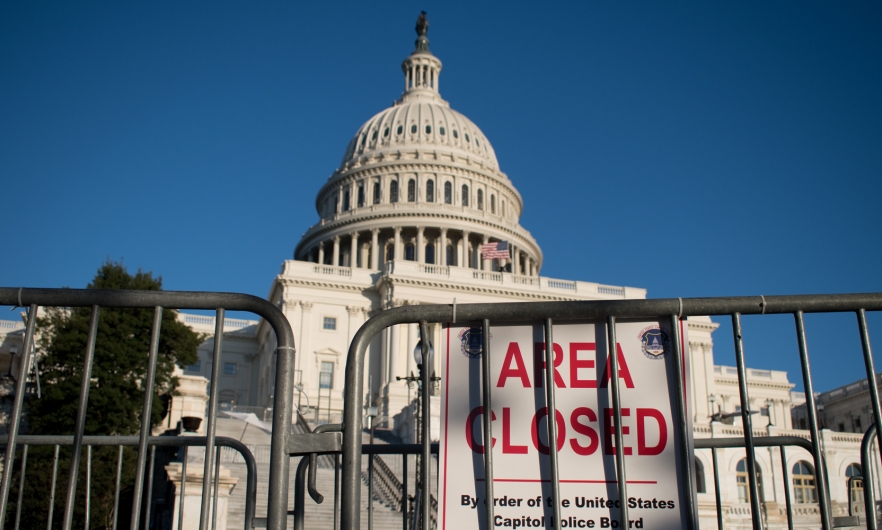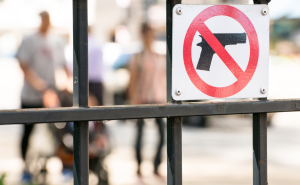How Armed Insurrection Threatens Public Health
A new report outlines how to limit the danger of insurrectionist attacks.

While the January 6, 2021, attack on the Capitol in Washington, D.C., may be the most egregious example of insurrection in recent memory, the threat of such incidents has increased as firearms continue to become more prevalent. Armed attacks aimed at disrupting civic engagement pose a risk to both public health and democracy, and signal the rise of a once fringe belief: that it’s acceptable to use violence to usurp majority rule.
In this Q&A, adapted from the January 5 episode of Public Health On Call, Stephanie Desmon speaks with Tim Carey, JD, law and policy adviser for the Center for Gun Violence Solutions and co-author of “Defending Democracy: Addressing the Dangers of Armed Insurrection,” a report that offers policy solutions for reducing the threat.
What can you tell us about this new report?
We are seeing risks across the country today not only of increased prevalence of guns and firearms in places critical to political participation—state legislatures, election offices, public demonstrations—but also people’s increasing willingness to use them. In political rhetoric, we have often heard people calling for the use of arms to achieve political ends, which is antithetical to not just public health and safety, but also the foundations of our democracy.
How did we get here?
There is a long history in our country of using violence to attempt to achieve political ends, such as the Whiskey Rebellion and Shays’ Rebellion, which were both attempts to overturn majority rule and democratic systems by using armed resistance. More modern history includes the Oklahoma City bombing by Timothy McVeigh, the shoot-outs and standoffs on ranches around the Midwest, and the various Bundy cases about using federal land.
There has also been a shift in rhetoric, from both gun advocacy organizations like the National Rifle Association and political figures, about the use of firearms to achieve political ends—not just as an option, but as our right—as a core interpretation of the Second Amendment.
It wasn't a sudden shift, but rather a slow escalation of what we call the Insurrectionary Second Amendment. This fringe idea is now entering mainstream discourse, where we hear public figures saying it and see people attempting to act on it. That's why we think it's critical to share more information about it now, as well as potential policy solutions to help address it, to prevent it from becoming a more significant problem with more significant consequences.
Are you talking about people who have insurrection as their goal? Or people who are angry and are carrying their weapons?
It's really hard to tell a person’s intentions when they’re carrying a firearm in public. That's become increasingly complicated by the stratification of state gun laws. In some states, you need a license to carry firearms in public, and you must go through certain tests to ensure that you meet some level of competency with a firearm before you bring it into the public sphere.
Other states are going far in the other direction, saying that you can carry in public without a license. You see far more firearms being used and displayed in public in states with permitless or “constitutional” carry. In these states, it's really unclear why someone would be carrying a firearm in a public place. It leads to great uncertainty as to what people are doing with these weapons and what it means for other people trying to share the spaces.
Were there guns at the January 6 insurrection?
Even though January 6 was indeed violent, the insurrection wasn't largely armed with firearms—and Washington, D.C.’s protective gun laws were a significant reason for that. Some groups were holding a stockpile of arms in Virginia, but those firearms didn't end up making it into the Capitol because of fear of enforcement over these laws. Even though that day was devastating and resulted in death and harm and fear, it was not as severe as it could have been, had these protections not been in place.
What can we do to make our society safer?
Washington, D.C., had protective laws that helped minimize some of the risk of harm that occurred, but many states don't. We saw what happened when these protections weren't in place, especially during the 2020 elections and the days that followed, and during the COVID-19 crisis and the lockdowns of several cities. The perhaps most well known example is the Michigan capitol, where viral videos show legislators looking up and seeing people with guns standing over them, trying to police what they were doing. It created an atmosphere of fear and concern that shook to the core their ability to make decisions on behalf of their constituents. We've also seen that outside of voting centers and public protests.
There are five policy recommendations we encourage states to adopt, as well as a practice recommendation that can be enacted without legislative action. Largely, these laws are focused on where firearms can be, who can carry them, and providing tools to use to prevent a crisis if a risk of violence is identified as credible. We have an evidence base for many of these laws and have seen that when implemented correctly, they can decrease violence and deadly outcomes.
What are some of your recommendations?
The first is regulating the public carrying of firearms. That doesn’t mean preventing wholesale the carrying of firearms in public. It means having mechanisms to ensure that people who carry firearms in public are legally allowed to carry firearms, that they have a degree of competency with safety training, or have had their fingerprints taken. Essentially, it means giving some sense that if someone is carrying a gun in public, they have a license or registration to do so.
We also suggest strengthening or creating laws that regulate paramilitary activity—what a lot of folks consider militias. That’s a misnomer, because the term militia refers to a body of the public that is armed and trained by local governments. A lot of paramilitary groups that we've seen showing up at events such as January 6 are not trained and led by the state. They're private individuals unaccountable to any will of any people aside from themselves. Mostly, these groups are outlawed, but some of these regulations are very old or not well enforced, if enforced at all. Ensuring that those laws are up to date, active, and being enforced can help mitigate the risks of armed groups trying to usurp public opinion.
We also encourage limiting or prohibiting firearms in places essential to political participation—polling places, legislative buildings, protests—to protect core functions of government and civil discourse. We've seen examples in the past few years of how firearms in these locations have not just caused physical harm, but also directly impeded the ability of ballots to be cast, legislators to do their jobs, and people to practice their First Amendment rights at protests.
Fourth, we ask for the enactment and implementation of extreme risk protection orders, also known as red flag laws, which allow states to temporarily disarm people who are posing a high risk of violence at that point in time. We also suggest creating, repealing, or amending state preemption laws to allow local governments to regulate firearms in certain situations.
Our last recommendation, which is not policy-based, is to break the insurrectionist permission structure by openly denouncing violence. We had other researchers at Johns Hopkins and partner universities do extensive political science research on the risk of partisan divides and willingness to engage in violence. The key finding was that when politicians and people who are viewed as leaders espouse violence, it can incite violence and make people who follow them willing to commit violence. If those same voices actively denounce violence, it makes people who look up to those leaders feel less likely or less willing to commit acts of violence.
We encourage states to adopt these policy recommendations and leaders to be very explicit in messaging that violence is never acceptable in political space. We need to leave room for the operations of government, civil rights, and public discourse.
Stephanie Desmon is the co-host of the Public Health On Call podcast. She is the director of public relations and communications for the Johns Hopkins Center for Communication Programs, the largest center at the Johns Hopkins Bloomberg School of Public Health.




